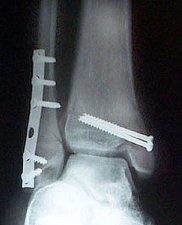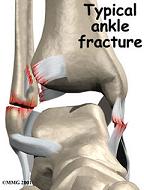|
Ankle FractureWhen discussing an ankle fracture, several different types come to mind. Those that are most commonly seen in the emergency room or orthopedic surgeon’s office will be discussed here in more detail.
The ankle is essentially made up of the lower portion of the fibula bone, otherwise known as the lateral malleolus, the lower end of the tibia (shin bone) or, the medial malleolus, and the talus bone of the ankle/foot. While this injury can be caused by many things, the most common factors include falls with twisting motions, sporting activities, and automobile accidents (such as the foot on the brake pedal during impact). The mechanism of injury can be, hyper plantar-flexion (bending downward), hyper dorsi-flexion (bending upward), inversion (rolling inward) or eversion (rolling outward).
The first injury type to be discussed involves the fibula, or lateral malleolus. This injury is frequently one-sided, meaning that only the fibula bone is involved. This can be seen in younger children whose growth plates are still “open”, thus making that area more vulnerable to injuries through them. That is not to say that adult bones can’t experience this injury type as well. That being said, however, there are instances where additional injury to other structures of the ankle can occur. The most frequently seen ankle fracture, in which only the fibula is fractured, can also have an associated ligament injury as well. This injury scenario would involve the fibula, or lateral malleolus fracture, and injury to the medial deltoid ligament which stabilizes the inner aspect of the ankle from the end of the tibia (medial malleolus) to the inner aspect of the bones of the mid-foot. It can also involve injury and damage to the small ligaments that connect between the fibula and the tibia bone in an area called the “syndesmosis”.
The more severe the fracture, the more structures of the ankle are damaged. One example of this is an injury that involves both the inner and outer knobs of the ankle. This is called a "bi-malleolar" fracture. In this scenario, both knobs of the ankle are broken, and this creates an unstable joint situation. This injury requires surgical stabilization of the fractured bones (see pictures)

In this x-ray, the broken fragments are "reduced", meaning put back into their anatomic positions, and restoring joint integrity. They are then held in place by the use of stainless steel (sometimes titanium) screws and occasionally, if the fracture type and severity warrants it, specially designed plates are used in combination with screws for a more stable repair.
Leave Ankle Fracture; return to Ankle Joint Pain
|

"We hope you enjoy your journey through Bone and Joint Pain.com"

